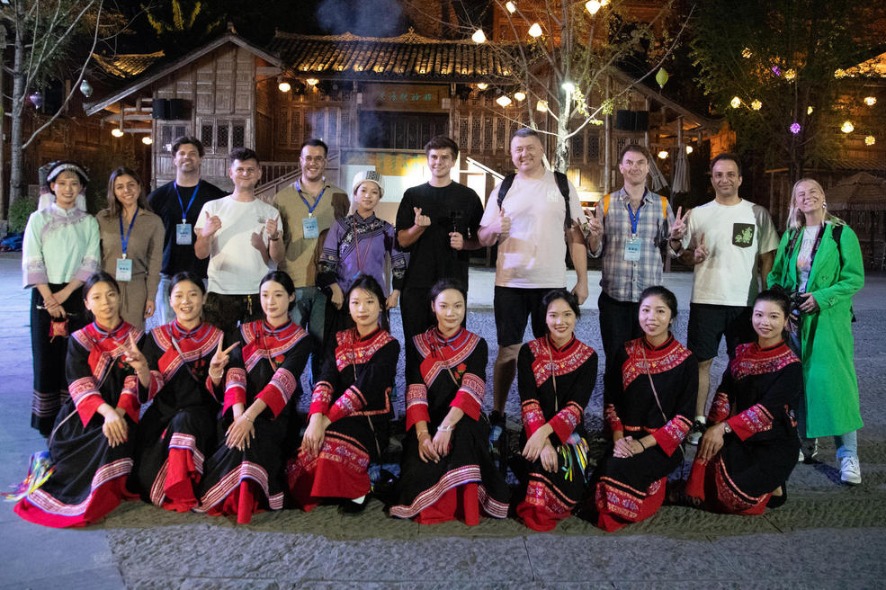Western region seeks quality growth


China's western region has high potential to realize high-quality development despite facing challenges in achieving Chinese-style modernization. At a symposium in Chongqing on how to boost the development of the western region in the new era on April 23, the top leader outlined a new development blueprint for the western region with "six adherences".
To form a new pattern of high-quality development, it is imperative to understand three factors — new pattern of high-quality development, new momentum of greater protection and openness, and new focus on regional coordinated development — and implement targeted measures in key areas.
As the western region advances toward achieving high-quality development, it seeks to forge a path of green, innovation-driven development. This approach is different from the previous one, which emphasized growth indicators, in that it prioritizes sustainable production activities, improvement of the natural environment and betterment of people's livelihoods.
Its centerpiece is to cultivate and develop industries that leverage the unique features of western China and establish an organic link between traditional and emerging industries. Within the strategic framework, the principle of coordinated development and security has been elevated to a new level, particularly in the development policy for the energy sector.
The new development policy will not only better conserve the ecology but also improve internal and external connectivity. By striking the right balance between economic development and ecological conservation, the western region has embarked on a distinctive path of high-quality development, facilitated by high-quality opening-up.
The essence of regional coordinated development is not to require regions to move forward at the same pace, but to advance together while balancing development and environmental protection.
As such, the western region should reinforce infrastructure construction, improve connectivity among cities in the region, and strive to form city clusters with strong competitiveness. There is also a need to foster coordinated development among the eastern, central and western regions by establishing a complementary regional development pattern through multidimensional and multilevel interactive cooperation.
The central and western regions, on their part, should deepen their partnership and build stronger regional cooperation mechanisms, so as to share the market, technological and information resources, and achieve common development. Promoting new quality productive forces keeping in mind the local conditions is key to unleashing the regional development potential and building advantageous industrial clusters.
The western region faces various challenges — it has a relatively weak economic foundation and a not-so-advanced industrial structure. So it should focus on utilizing local resources and advantages, use innovation to transform traditional industries, and chart a new high-quality development path based on regional features, instead of blindly pursuing fast-paced development of high-tech sectors.
For example, the Sichuan-Chongqing region can take advantage of its economic and natural resources, and talents to develop high-growth industries such as equipment manufacturing, new energy, new materials and biomedicine, and leverage the geographical advantages of the Chengdu-Chongqing economic circle to build a science and technology corridor, boost science and technology exchanges, and realize industrial upgrading.
The Xinjiang Uygur autonomous region, on the other hand, can capitalize on its abundant natural resources and unique geographical location to develop industries such as modern agriculture, clean energy and cultural tourism. By adopting such a development model, different areas of the western region can leverage their own advantages and form a new regional development pattern marked by complementary advantages.
The new development principle based on innovation, coordination, openness and sharing should serve as a guide for the western region's development. In fact, by promoting greater protection and openness, the new policy highlights the importance of green development.
As a provider of national ecological security, the western region must prioritize environmental protection and ecological conservation, and work out construction plans in a way that causes minimum damage to the environment and ecology. A series of policy and measures, such as the construction of a park city in Chengdu, Sichuan province, the development of clean energy in Qinghai province, and the natural ecology conservation plan in Gansu province, indicates the western region is exploring an innovation-driven green development path.
The open development concept requires the western region to leverage its geographical advantages brought about by the Belt and Road Initiative to promote high-quality opening-up, and further integrate with the global economic and trade networks.
Against this backdrop, the emergence of inland open frontiers, such as the Xi'an International Port Area and Lanzhou New Area Comprehensive Bonded Zone, marks the gradual transformation of the western region into a crucial bridge connecting the internal and external markets, and redefines the inland region's important role in global competition and cooperation.
Moreover, the construction of railway corridors, such as the China-Europe Railway Express which departs from Chengdu and Lanzhou, has established a vital trade artery connecting Asia and Europe. These corridors have also opened up new markets for traditional industries in the western region, including steel, cement and coal.
The success of the western region's development policy in the new era depends on two factors: government policy support and reform and innovation. An efficient policy support system is urgently needed to further improve connectivity and smoothen operations throughout the process, from top-level planning to local implementation. And while specific actions need to be taken to optimize the western region's business environment, boost market vitality and stimulate social creativity, efforts must be made to provide adequate funding and tax incentives for the development of advantageous industries in the region.

The views don't necessarily reflect those of China Daily.
If you have a specific expertise, or would like to share your thought about our stories, then send us your writings at opinion@chinadaily.com.cn, and comment@chinadaily.com.cn.































